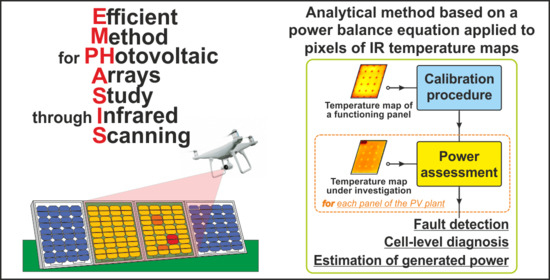Using EMPHASIS for the Thermography-Based Fault Detection in Photovoltaic Plants
Abstract
:1. Introduction
2. EMPHASIS
- Pg,A is the electrical power generated (or, if negative, dissipated) in the area A; the quantity 0.95⸱G⸱A–Pg,A corresponds to the power giving rise to the thermalization process.
- The ratio between the temperature increment averaged on A (Tavg,A–Tamb) and the positive quantity rA is representative of the upward heat flux through the panel front surface (i.e., the thermal power vertically flowing from the cells to the ambient). Here, rA has the dimensions of a thermal resistance [K/W] and accounts for the thermal behavior of the panel. It depends on the panel characteristics (i.e., geometry and materials) as well as on the ambient conditions. Since the PV panel temperature is typically higher than the ambient one, such a ratio is expected to be positive.
- The thermal power Pout,A represents that the heat horizontally moving in and out from the specific area A; Pout,A is positive (negative) in presence of an outgoing (ingoing) effective horizontal heat flux.
- the first stage, also referred to as calibration procedure, is performed only once on temperature maps of functioning panels, the generated power of which (Pg,panel) must be known. The calibration procedure identifies the rA distribution—representing the only unknown in Equation (1). While Pout,A and Tavg,A are obtained as stated before, each Pg,A value can be derived as Pg,panel∙A/Aglass, where Aglass is the area of the panel front surface;
- the second stage, denoted as power assessment, is performed on temperature maps of panels working under unknown electrical conditions (i.e., Pg,panel is undetermined). To identify the energy production of the panel, the power assessment (i) exploits the rA distribution extracted in the calibration procedure and (ii) solves Equation (1) for Pg,A.
2.1. Standard Approach
2.2. NL-Corrected Approach
2.3. Differential Approach
3. “Simulated Experiments” Methodology
- a commercial PV panel (Section 3.1) was tested by on-field measurements (Section 3.2);
- an ET macrocircuit in a SPICE-like environment was exploited to emulate the ET behavior of the PV panel (Section 3.3);
- a real PV panel was replicated in a commercial FEM software package (Section 3.4) and thermal simulations were performed to extract temperature maps under many working and environmental conditions. Such maps emulate the realistic PV panel thermal behavior as if they were taken through IR scanning. The key point is that—in contrast to IR scanning—the cell-level working conditions (i.e., the Pg,cell distribution obtained by the ET macrocircuit) are known and can be used as a reference; these temperature maps were fed to EMPHASIS that provided a prediction of the Pg,cell values.
3.1. PV Panel under Investigation
3.2. On-Field Measurements
3.3. SPICE Electrothermal Model
- a variation of the environmental conditions by acting on Tamb and G;
- any malfunction event, such as a shunt fault by simply reducing the shunt resistance (Rsh) value of the individual cells;
- a partial shading that may lead to localized hotspots, emulated by reducing the G value of the shaded cells.
3.4. FEM Simulations
4. “Simulated Experiments” Results
- Case #1—denoted as MPP—corresponds to a functioning panel working under the MPP condition. The MPP map was used in the calibration procedures;
- Case #2—denoted as OC—refers to a functioning panel operating under OC conditions. The OC map was used in the calibration procedures;
- Case #3—denoted as SHUNT—replicates the occurrence of a shunted cell, which does not contribute to the power generation. More specifically, in the SHUNT case, the Rsh value of cell #34 was preventively decreased by a factor 100 in the SPICE-like environment. The SHUNT map was processed in the power assessment stage.
- Case #4—denoted as HOTSPOT—emulates the partial shading of a cell leading to a localized hotspot. To this aim, the G value impinging on cell #5 was reduced to 80%. The HOTSPOT map was processed in the power assessment stage.
5. Conclusions
Author Contributions
Funding
Institutional Review Board Statement
Informed Consent Statement
Data Availability Statement
Acknowledgments
Conflicts of Interest
Nomenclature
| 2-D | Two-dimensional |
| 3-D | Three-dimensional |
| Acell | Cell area |
| Aglass | Panel front surface |
| Apixel | Pixel area |
| BC | Boundary condition |
| EMPHASIS | Efficient Method for PHotovoltaic Arrays Study through Infrared Scanning |
| ET | Electrothermal |
| EVA | Ethylene vinyl acetate |
| FEM | Finite-element method |
| G | Solar irradiance |
| Gexp | Experimental solar irradiance |
| hback | Heat transfer coefficients on the back surface |
| hfront | Heat transfer coefficients on the front surface |
| Iph | Photogenerated current |
| IR | Infrared |
| ISC | Short-circuit current |
| k | Thermal conductivity |
| MPP | Maximum-power-point |
| NL | Nonlinear |
| OC | Open-circuit |
| PD | Dissipated power |
| Pg,cell | Electrical power generated by the cell |
| Pg,panel | Electrical power generated by the panel |
| PV | Photovoltaic |
| ri | Tuning parameter |
| Rs | Series resistance |
| Rsh | Shunt resistance |
| RSMH | Cell self- and mutual-heating resistance |
| Si | Silicon |
| STC | Standard test conditions |
| T0 | Reference temperature in the FEM solver |
| Tamb | Ambient temperature |
| Tglass | Front surface temperature |
| tglass | Glass thickness |
| Ti | Pixel-level front surface temperature |
| VOC | Open-circuit voltage |
References
- Maycock, P.D. Photovoltaics: PV market update. In Renewable Energy World. 2005. Available online: https://inis.iaea.org/search/search.aspx?orig_q=RN:37002952 (accessed on 1 September 2020).
- Kurokawa, K.; Kato, K.; Ito, M.; Komoto, K.; Kichimi, T.; Sugihara, H. A cost analysis of very large scale PV (VLS-PV) system on the world deserts. Proceedings of IEEE Photovoltaic Specialists Conference, New Orleans, LA, USA, 19–24 May 2002; pp. 1672–1675. [Google Scholar]
- Shah, R.; Mithulananthan, N.; Lee, K.Y. Large-scale PV plant with a robust controller considering power oscillation damping. IEEE Trans. Energy Convers. 2012, 28, 106–116. [Google Scholar] [CrossRef]
- Shuchao, W.; Shengpeng, D.; Wei, H.; Jun, C.; Xicai, Z. Three-level agc for large-scale PV power plant with string inverters. In Proceedings of the IEEE International Conference on Power System Technology (POWERCON), Wollongong, Australia, 28 September–1 October 2016. [Google Scholar]
- Clement-Nyns, K.; Haesen, E.; Driesen, J. The impact of charging plug-in hybrid electric vehicles on a residential distribution grid. IEEE Trans. Power Syst. 2009, 25, 371–380. [Google Scholar] [CrossRef] [Green Version]
- Lawder, M.T.; Suthar, B.; Northrop, P.W.; De, S.; Hoff, C.M.; Leitermann, O.; Crow, M.L.; Santhanagopalan, S.; Subramanian, V.R. Battery energy storage system (BESS) and battery management system (BMS) for grid-scale applications. Proc. IEEE 2014, 102, 1014–1030. [Google Scholar] [CrossRef]
- Wang, G.; Ciobotaru, M.; Agelidis, V.G. Power smoothing of large solar PV plant using hybrid energy storage. IEEE Trans. Sustain. Energy 2014, 5, 834–842. [Google Scholar] [CrossRef]
- Kroposki, B.; Johnson, B.; Zhang, Y.; Gevorgian, V.; Denholm, P.; Hodge, B.M.; Hannegan, B. Achieving a 100% renewable grid: Operating electric power systems with extremely high levels of variable renewable energy. IEEE Power Energy Mag. 2017, 15, 61–73. [Google Scholar] [CrossRef]
- Beltran, H.; Bilbao, E.; Belenguer, E.; Etxeberria-Otadui, I.; Rodriguez, P. Evaluation of storage energy requirements for constant production in PV power plants. IEEE Trans. Ind. Electron. 2012, 60, 1225–1234. [Google Scholar] [CrossRef]
- Begum, S.; Banu, R.; Ahammed, G.A.; Parameshachari, B.D. Performance degradation issues of PV solar power plant. In Proceedings of the IEEE International Conference on Electrical Electronics, Communication, Computer, and Optimization Techniques (ICEECCOT), Karnataka, India, 15–16 December 2017; pp. 311–313. [Google Scholar]
- Livera, A.; Theristis, M.; Makrides, G.; Georghiou, G.E. Recent advances in failure diagnosis techniques based on performance data analysis for grid-connected photovoltaic systems. Renew. Energy 2019, 133, 126–143. [Google Scholar] [CrossRef]
- Xia, L.; Wen, Z.; Liao, K.; Chen, J.; Li, Q.; Luo, X. Unveiling the Failure Mechanism of Electrical Interconnection in Thermal-Aged PV Modules. IEEE Trans. Device Mater. Reliab. 2019, 20, 24–32. [Google Scholar] [CrossRef]
- Ebrahim, A.F.; Youssef, T.; Ahmed, S.M.W.; Elmasry, S.E.; Mohammed, O.A. Fault detection and compensation for a PV system grid tie inverter. In Proceedings of the IEEE North American Power Symposium (NAPS), Pullman, WA, USA, 7–9 September 2014. [Google Scholar]
- Khalil, M. Failure prediction of PV inverters under operational stresses. In Proceedings of the IEEE International Conference on Environment and Electrical Engineering and IEEE Industrial and Commercial Power Systems Europe (EEEIC/I&CPS Europe), Genoa, Italy, 11–14 June 2019. [Google Scholar]
- Brooks, A.E.; Cormode, D.; Cronin, A.D.; Kam-Lum, E. PV system power loss and module damage due to partial shade and bypass diode failure depend on cell behavior in reverse bias. Proceedings of IEEE 42nd Photovoltaic Specialist Conference (PVSC), New Orleans, LA, USA, 14–19 June 2015. [Google Scholar]
- Manganiello, P.; Balato, M.; Vitelli, M. A Survey on Mismatching and Aging of PV Modules: The Closed Loop. Ieee Trans. Ind. Electron. 2015, 62, 7276–7286. [Google Scholar] [CrossRef]
- Satpute, R.G.; Morey, S.B.; Shende, P.A.; Deshmukh, Y.B. Shunt Faults Analysis of Solar PV-Based AC Standalone System. Proceedings of International Conference on Innovative Trends and Advances in Engineering and Technology (ICITAET), Sheagon, India, 27–28 December 2019; pp. 73–78. [Google Scholar]
- Rossi, D.; Omaña, M.; Giaffreda, D.; Metra, C. Modeling and Detection of Hotspot in Shaded Photovoltaic Cells. IEEE Trans. Very Large Scale Integr. (Vlsi) Syst. 2015, 23, 1031–1039. [Google Scholar] [CrossRef] [Green Version]
- Daliento, S.; Chouder, A.; Guerriero, P.; Pavan, A.M.; Mellit, A.; Moeini, R.; Tricoli, P. Monitoring, diagnosis, and power forecasting for photovoltaic fields: A review. Int. J. Photoenergy 2017. [Google Scholar] [CrossRef]
- Stellbogen, D. Use of PV circuit simulation for fault detection in PV array fields. Proceedings of IEEE Photovoltaic Specialists Conference, Louisville, KY, USA, 10–14 May 1993; pp. 1302–1307. [Google Scholar]
- Haeberlin, H.; Beutler, C. Normalized representation of energy and power for analysis of performance and on-line error detection in PV-systems. In Proceedings of the European Photovoltaic Solar Energy Conference, Nice, France, 23–27 October 1995. [Google Scholar]
- Chouder, A.; Silvestre, S. Automatic supervision and fault detection of PV systems based on power losses analysis. Energy Convers. Manag. 2010, 51, 1929–1937. [Google Scholar] [CrossRef]
- Drews, A.; De Keizer, A.C.; Beyer, H.G.; Lorenz, E.; Betcke, J.; Van Sark, W.G.J.H.M.; Heydenreich, W.; Wiemken, E.; Stettler, S.; Toggweiler, P.; et al. Monitoring and remote failure detection of grid-connected PV systems based on satellite observations. Sol. Energy 2007, 81, 548–564. [Google Scholar] [CrossRef] [Green Version]
- Vergura, S.; Acciani, G.; Amoruso, V.; Patrono, G.E.; Vacca, F. Descriptive and inferential statistics for supervising and monitoring the operation of PV plants. Ieee Trans. Ind. Electron. 2009, 56, 4456–4464. [Google Scholar] [CrossRef]
- Guerriero, P.; Piegari, L.; Rizzo, R.; Daliento, S. Mismatch based diagnosis of PV fields relying on monitored string currents. Int. J. Photoenergy 2017. [Google Scholar] [CrossRef] [Green Version]
- Sánchez-Pacheco, F.J.; Sotorrío-Ruiz, P.J.; Heredia-Larrubia, J.R.; Pérez-Hidalgo, F.; Sidrach De Cardona, M. PLC-based PV plants smart monitoring system: Field measurements and uncertainty estimation. IEEE Trans. Instrum. Meas. 2014, 63, 2215–2222. [Google Scholar] [CrossRef]
- Guerriero, P.; Di Napoli, F.; Vallone, G.; d’Alessandro, V.; Daliento, S. Monitoring and diagnostics of PV plants by a wireless self-powered sensor for individual panels. IEEE J. Photovolt. 2016, 6, 286–294. [Google Scholar] [CrossRef]
- Bellezza Quater, P.; Grimaccia, F.; Leva, S.; Mussetta, M.; Aghaei, M. Light Unmanned Aerial Vehicles (UAVs) for cooperative inspection of PV plants. IEEE J. Photovolt. 2014, 4, 1107–1113. [Google Scholar] [CrossRef] [Green Version]
- Hu, Y.; Cao, W.; Ma, J.; Finney, S.J.; Li, D. Identifying PV module mismatch faults by a thermography-based temperature distribution analysis. IEEE Trans. Device Mater. Reliab. 2014, 14, 951–960. [Google Scholar] [CrossRef] [Green Version]
- Tsanakas, J.A.; Chrysostomou, D.; Botsaris, P.N.; Gasteratos, A. Fault diagnosis of photovoltaic modules through image processing and Canny edge detection on field thermographic measurements. Int. J. Sustain. Energy 2015, 34, 351–372. [Google Scholar] [CrossRef]
- Vergura, S.; Marino, F. Quantitative and computer-aided thermography-based diagnostics for PV devices: Part I—Framework. IEEE J. Photovolt. 2017, 7, 822–827. [Google Scholar] [CrossRef]
- Vergura, S.; Colaprico, M.; de Ruvo, M.F.; Marino, F. A quantitative and computer-aided thermography-based diagnostics for PV devices—Part II: Platform and results. IEEE J. Photovolt. 2017, 7, 237–243. [Google Scholar] [CrossRef]
- Aghaei, M.; Grimaccia, F.; Gonano, C.A.; Leva, S. Innovative automated control system for PV fields inspection and remote control. IEEE Trans. Ind. Electron. 2015, 62, 7287–7296. [Google Scholar] [CrossRef]
- Aghaei, M.; Gandelli, A.; Grimaccia, F.; Leva, S.; Zich, R.E. IR real-time analyses for PV system monitoring by digital image processing techniques. In Proceedings of the International Conference on Event-Based Control, Communication and Signal Processing (EBCCSP), Krakow, Poland, 17–19 June 2015. [Google Scholar]
- Dotenco, S.; Dalsass, M.; Winkler, L.; Würzner, T.; Brabec, C.; Maier, A.; Gallwitz, F. Automatic detection and analysis of photovoltaic modules in aerial infrared imagery. In Proceedings of the IEEE Winter Conference on Applications of Computer Vision (WACV), New York, NY, USA, 7–9 March 2016. [Google Scholar]
- Guerriero, P.; Di Napoli, F.; Daliento, S. Real time monitoring of solar fields with cost/revenue analysis of fault fixing. In Proceedings of the IEEE International Conference on Environment and Electrical Engineering (EEEIC), Florence, Italy, 7–10 June 2016. [Google Scholar]
- Chine, W.; Mellit, A.; Lughi, V.; Malek, A.; Sulligoi, G.; Massi Pavan, A. A novel fault diagnosis technique for photovoltaic systems based on artificial neural networks. Renew. Energy 2016, 90, 501–512. [Google Scholar] [CrossRef]
- Kim, I.-S. On-line fault detection algorithm of a photovoltaic system using wavelet transform. Sol. Energy 2016, 126, 137–145. [Google Scholar] [CrossRef]
- Karatepe, E.; Hiyama, T. Controlling of artificial neural network for fault diagnosis of photovoltaic array. Proceedings of IEEE International Conference on Intelligent System Applications to Power Systems (ISAP), Hersonissos, Greece, 25–28 September 2011. [Google Scholar]
- Catalano, A.P.; Guerriero, P.; d’Alessandro, V.; Codecasa, L.; Daliento, S. An approach to the cell-level diagnosis of malfunctioning events in PV panels from aerial thermal maps. In ELECTRIMACS 2019 Selected Papers-Volume 2; Springer: Cham, Switzerland, 2020; p. 697, (Lecture Notes in Electrical Engineering). [Google Scholar]
- Guerriero, P.; Catalano, A.P.; Matacena, I.; Codecasa, L.; d’Alessandro, V.; Daliento, S. Experimental assessment of malfunction events in photovoltaic modules from IR thermal maps. In Proceedings of the IEEE International Workshop on Thermal Investigations of ICs and Systems (THERMINIC), Lecco, Italy, 25–27 September 2019. [Google Scholar]
- ET-M54050. Available online: http://www.etsolar.com.ar/folletos/ET-M54050(50w).pdf (accessed on 1 September 2020).
- Fluke TiS55 Infrared Camera. Available online: https://www.fluke.com/en-us/product/thermal-cameras/tis55# (accessed on 4 September 2020).
- PSPICE User’s Manual, Cadence OrCAD 16.5. 2011. Available online: https://www.seas.upenn.edu/~jan/spice/PSpice_CaptureGuideOrCAD.pdf (accessed on 4 September 2020).
- Guerriero, P.; Codecasa, L.; d’Alessandro, V.; Daliento, S. Dynamic electro-thermal modeling of solar cells and modules. Sol. Energy 2019, 179, 326–334. [Google Scholar] [CrossRef]
- Zekry, A.; Al-Mazroo, A.Y. A distributed SPICE-model of a solar cell. IEEE Trans. Electron Devices 1996, 43, 691–700. [Google Scholar] [CrossRef]
- d’Alessandro, V.; Catalano, A.P.; Codecasa, L.; Moser, B.; Zampardi, P.J. Modeling thermal coupling in bipolar power amplifiers toward dynamic electrothermal simulation. In Proceedings of the IEEE MTT-S International Conference on Numerical Electromagnetic and Multiphysics Modeling and Optimization (NEMO), Reykjavik, Iceland, 8–10 August 2018. [Google Scholar]
- d’Alessandro, V.; Catalano, A.P.; Codecasa, L.; Moser, B.; Zampardi, P.J. Combined SPICE-FEM analysis of electrothermal effects in InGaP/GaAs HBT devices and arrays for handset applications. In Proceedings of the IEEE International Conference on Thermal, Mechanical and Multi-Physics Simulation and Experiments in Microelectronics and Microsystems (EuroSimE), Toulouse, France, 16–18 April 2019. [Google Scholar]
- COMSOL Multiphysics, User’s Guide, Release 5.3A. 2018. Available online: https://cdn.comsol.com/doc/5.3a/COMSOL_ReleaseNotes.pdf (accessed on 1 September 2020).
- d’Alessandro, V.; Catalano, A.P.; Codecasa, L.; Zampardi, P.J.; Moser, B. Accurate and efficient analysis of the upward heat flow in InGaP/GaAs HBTs through an automated FEM-based tool and Design of Experiments. Int. J. Numer. Model. Electron. Netw. Devices Fields 2019, 32, e2530. [Google Scholar] [CrossRef]
- Catalano, A.P.; Scognamillo, C.; d’Alessandro, V.; Castellazzi, A. Numerical analysis and analytical modeling of the thermal behavior of single-and double-sided cooled power modules. IEEE Trans. Compon. Packag. Manuf. Technol. 2020, 10, 1446–1453. [Google Scholar] [CrossRef]
- Catalano, A.P.; Magnani, A.; d’Alessandro, V.; Codecasa, L.; Rinaldi, N.; Moser, B.; Zampardi, P.J. Numerical analysis of the thermal behavior sensitivity to technology parameters and operating conditions in InGaP/GaAs HBTs. Proceedings of IEEE the Compound Semiconductor Integrated Circuit Symposium (CSICS), Miami, FL, USA, 22–25 October 2017. [Google Scholar]
- Armstrong, S.; Hurley, W.G. A thermal model for photovoltaic panels under varying atmospheric conditions. Appl. Therm. Eng. 2010, 30, 1488–1495. [Google Scholar] [CrossRef]
- Lienhard, J.H., IV; Lienhard, J.H., V. A Heat Transfer Textbook; Phlogiston Press: Cambridge, MA, USA, 2008. [Google Scholar]
- Catalano, A.P.; d’Alessandro, V.; Guerriero, P.; Daliento, S. Diagnosis of power losses in PV plants by means of UAV thermography. In Proceedings of the IEEE International Conference on Clean Electrical Power (ICCEP), Otranto, Italy, 2–4 July 2019; pp. 306–310.
- Palankovski, W.; Quay, R. Analysis and Simulation of Heterostructure Devices; Springer: New York, NY, USA, 2004. [Google Scholar]

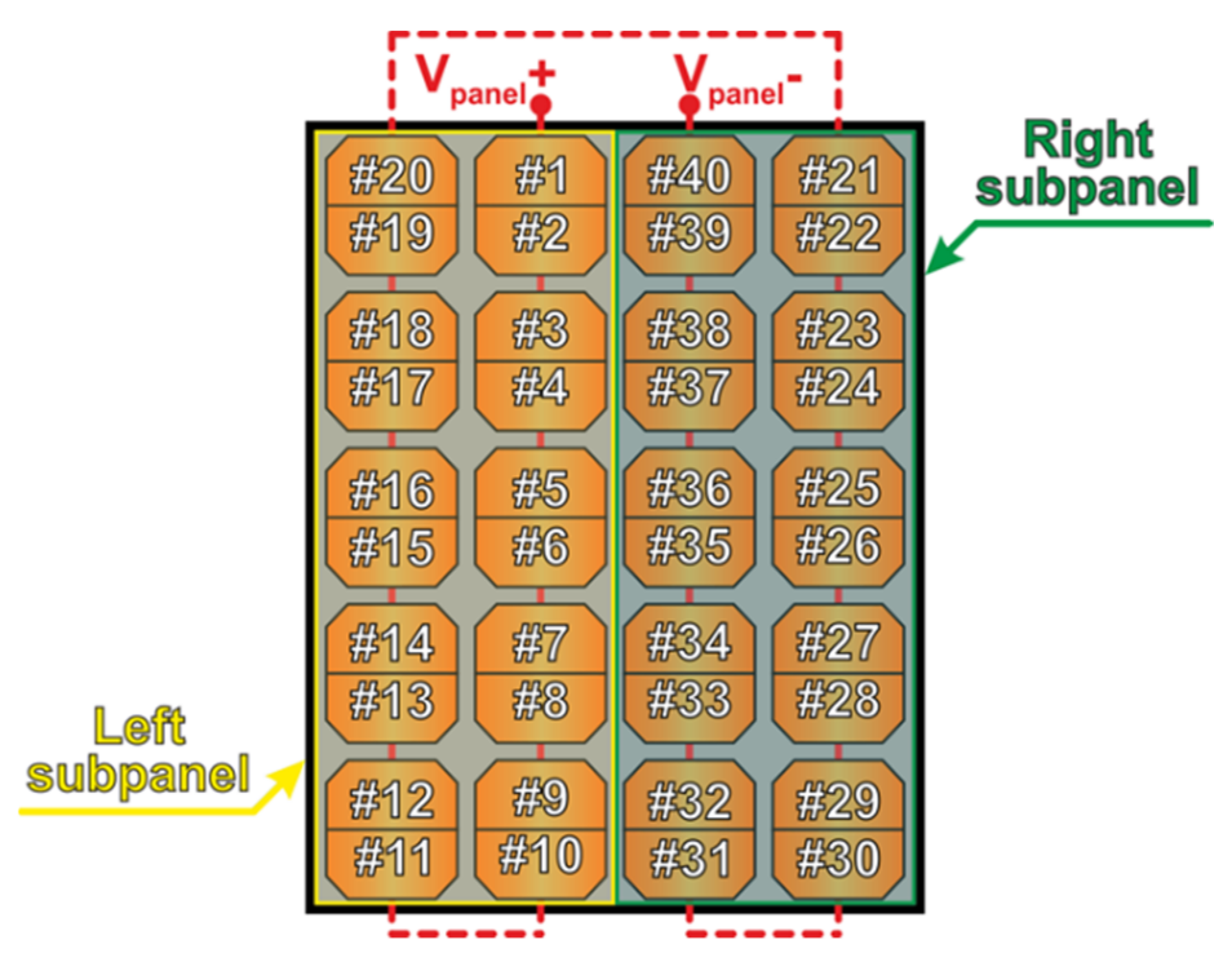

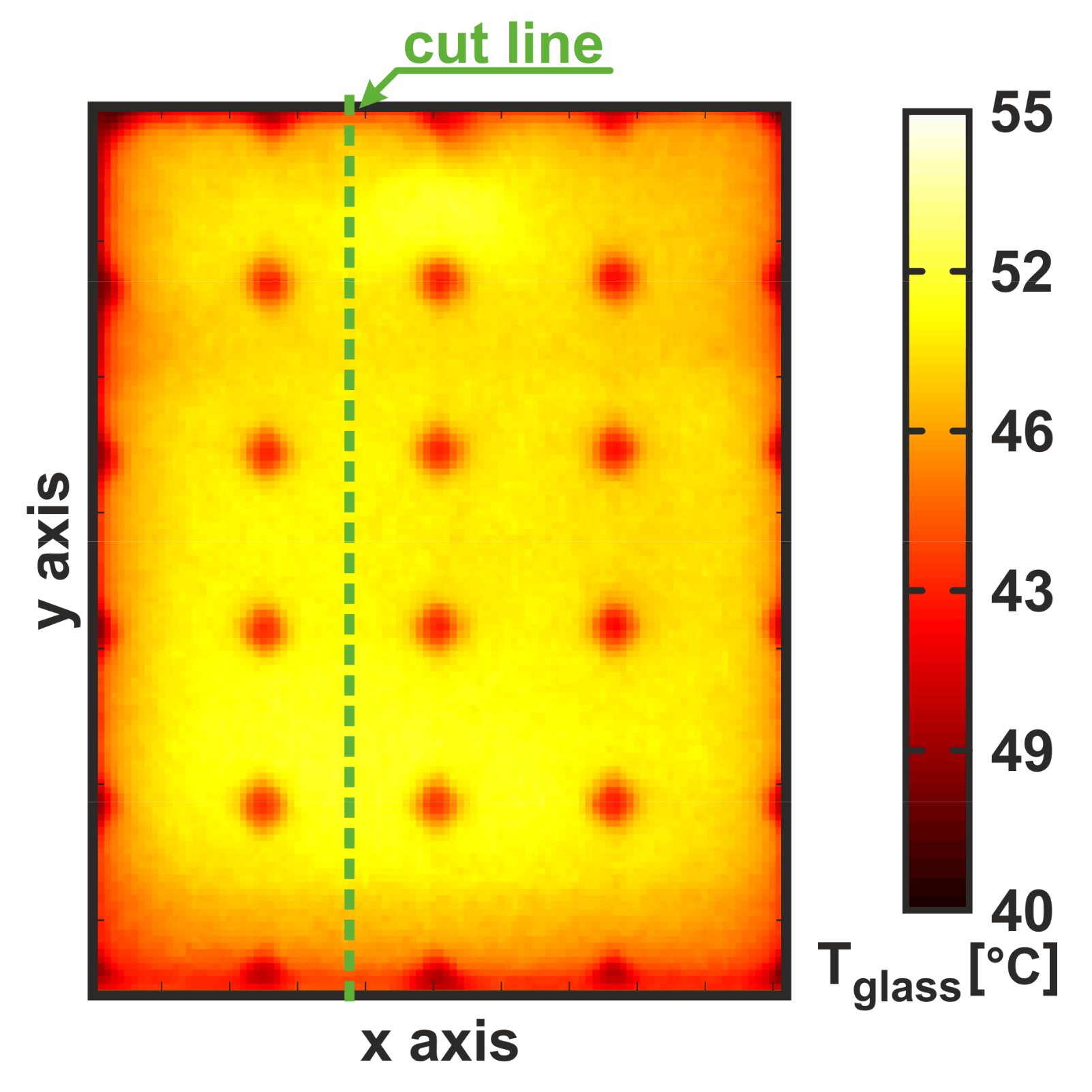

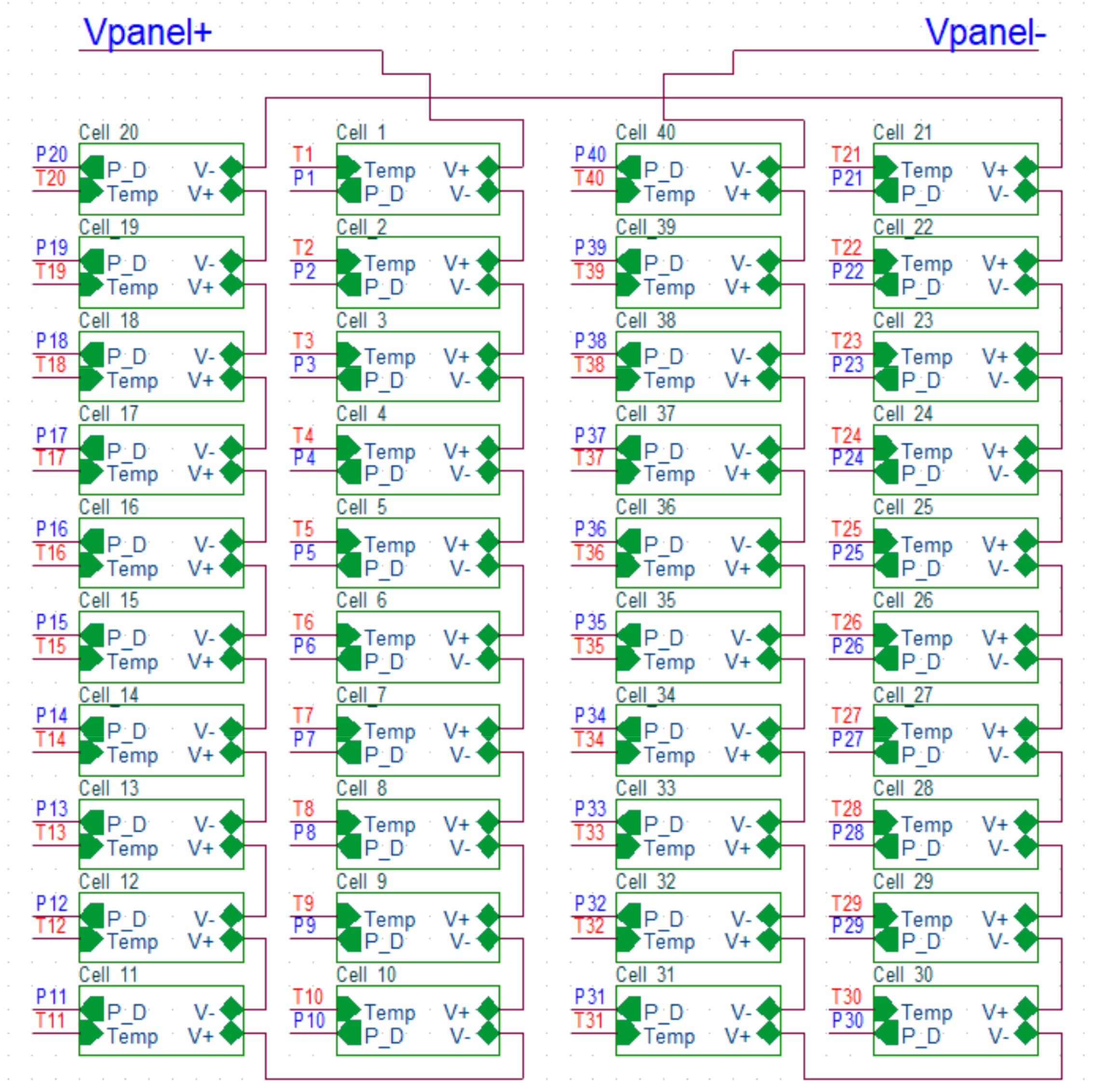



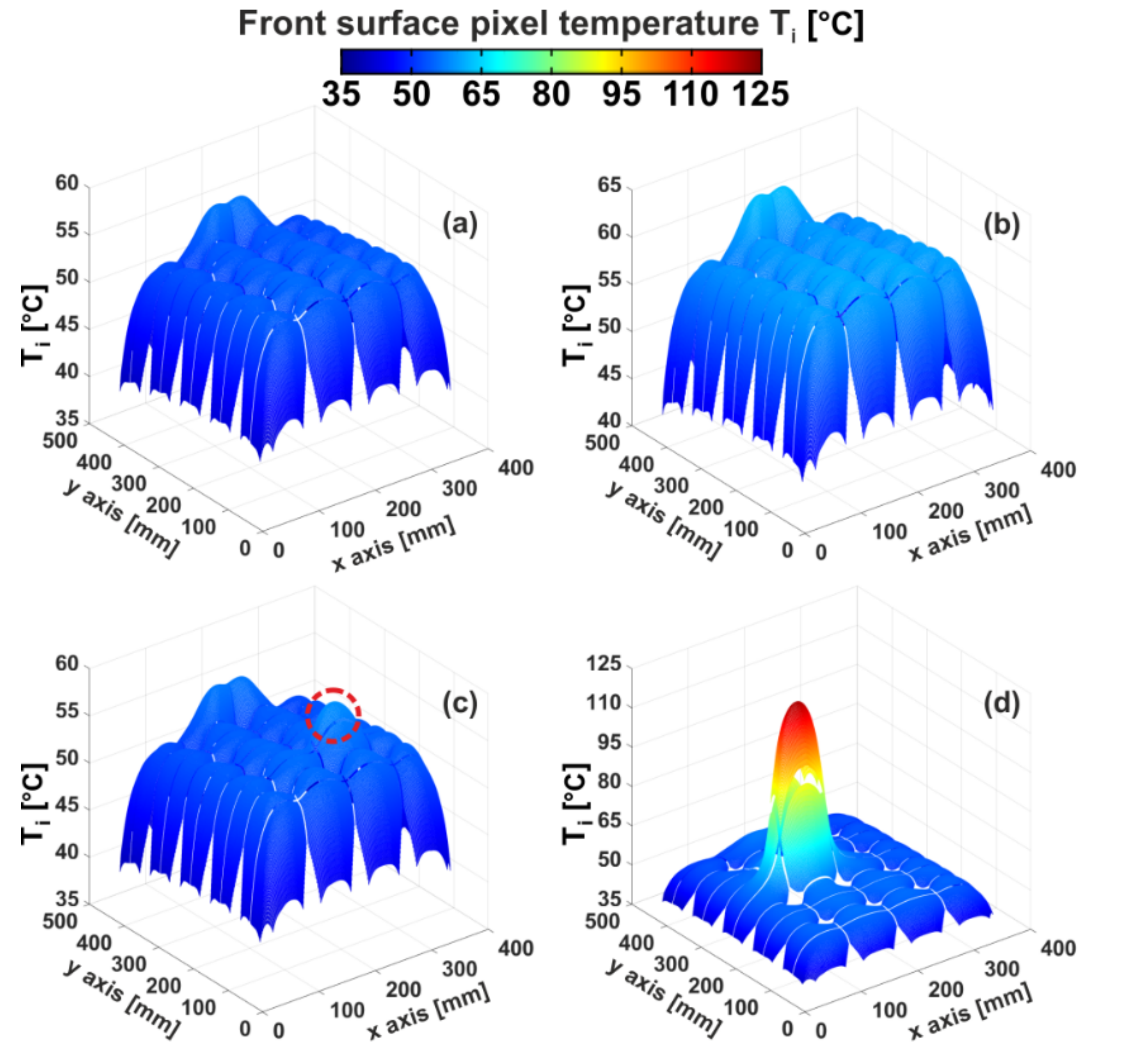
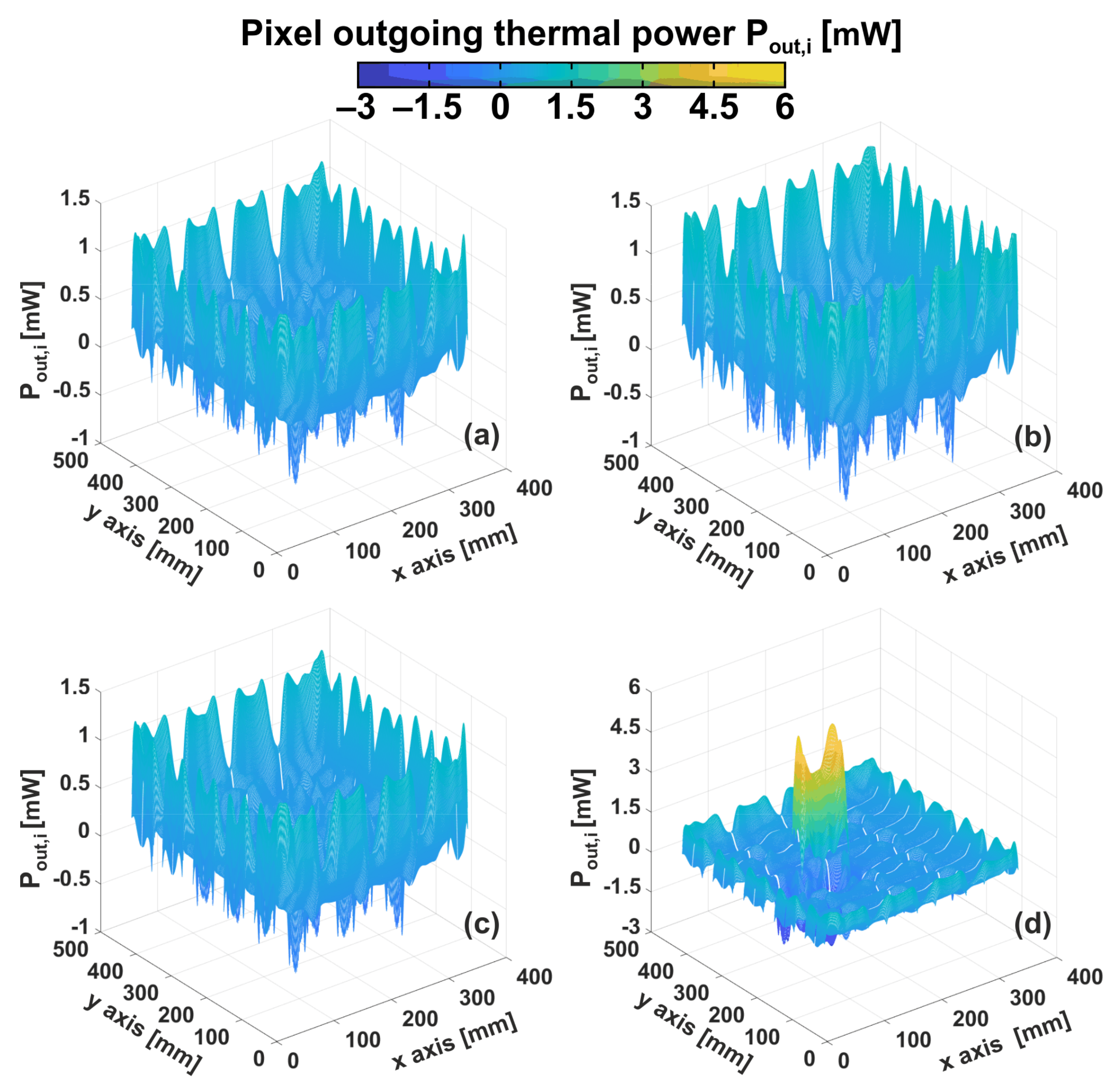


| Material | k(T0) (W/mK) |
|---|---|
| Si | 148 [53] |
| Glass | 1.8 [53] |
| EVA | 0.35 [53] |
| Tedlar | 0.15 [53] |
| Aluminum | 237 [54] |
| Case #3—SHUNT | Case #4—HOTSPOT | |||||
|---|---|---|---|---|---|---|
| Left Subpanel | Right Subpanel | Whole Panel | Left Subpanel | Right Subpanel | Whole Panel | |
| Standard approach | 24.10 W (−0.38 W) | 22.98 W (−0.31 W) | 47.09 W (−0.58 W) | 1.52 W (+3.27 W) | 24.86 W (+0.47 W) | 26.38 W (+3.75 W) |
| NL-corrected approach | 24.10 W (−0.38 W) | 22.93 W (−0.36 W) | 47.03 W (−0.64 W) | −0.08 W (+1.68 W) | 24.76 W (+0.37 W) | 24.67 W (+2.04 W) |
| Differential approach | 24.10 W (−0.38 W) | 22.93 W (−0.36 W) | 47.03 W (−0.64 W) | 0.83 W (+2.6 W) | 24.77 W (+0.38 W) | 25.59 W (+2.96 W) |
| Reference | 24.38 W | 23.29 W | 47.67 W | −1.75 W | 24.39 W | 22.63 W |
| SHUNT Case | HOTSPOT Case | |||
|---|---|---|---|---|
| Malfunctioning Cell Error | Panel-Level Error | Malfunctioning Cell Error | Panel-Level Error | |
| Method in [40] | +0.15 W | −0.45 W | −5.77 W | +4.38 W |
| EMPHASIS standard approach | −0.07 W | −0.58 W | −1.52 W | +3.75 W |
| Method in [41] | – | – | +9.27 W | +9.81 W |
| EMPHASIS differential approach | – | – | +1.01 W | +2.04 W |
Publisher’s Note: MDPI stays neutral with regard to jurisdictional claims in published maps and institutional affiliations. |
© 2021 by the authors. Licensee MDPI, Basel, Switzerland. This article is an open access article distributed under the terms and conditions of the Creative Commons Attribution (CC BY) license (http://creativecommons.org/licenses/by/4.0/).
Share and Cite
Catalano, A.P.; Scognamillo, C.; Guerriero, P.; Daliento, S.; d’Alessandro, V. Using EMPHASIS for the Thermography-Based Fault Detection in Photovoltaic Plants. Energies 2021, 14, 1559. https://doi.org/10.3390/en14061559
Catalano AP, Scognamillo C, Guerriero P, Daliento S, d’Alessandro V. Using EMPHASIS for the Thermography-Based Fault Detection in Photovoltaic Plants. Energies. 2021; 14(6):1559. https://doi.org/10.3390/en14061559
Chicago/Turabian StyleCatalano, Antonio Pio, Ciro Scognamillo, Pierluigi Guerriero, Santolo Daliento, and Vincenzo d’Alessandro. 2021. "Using EMPHASIS for the Thermography-Based Fault Detection in Photovoltaic Plants" Energies 14, no. 6: 1559. https://doi.org/10.3390/en14061559






